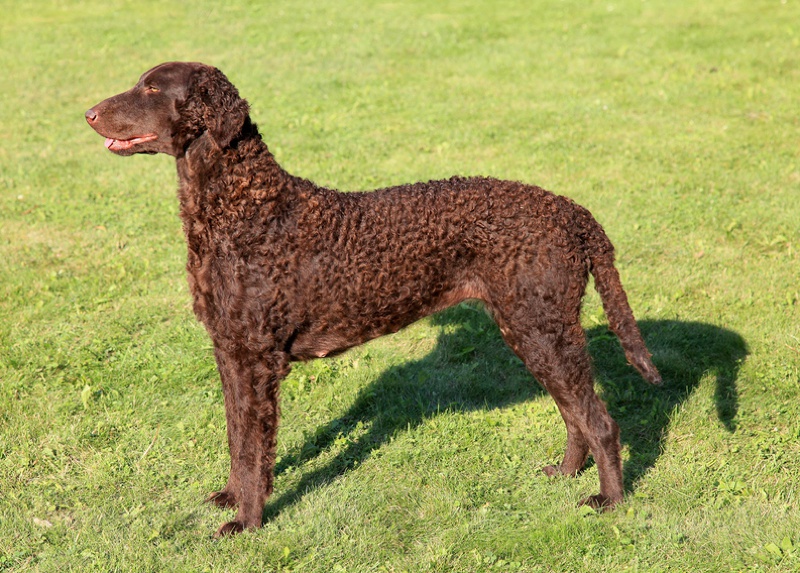Curly Coated Retriever

The Curly Coated Retriever, along with the Flat Coated Retriever, is the oldest of the retriever breeds. They were developed in England to recover game birds on land and in the water. As such, they are very active dogs who love to spend time with their owners on outdoor excursions. They are not as effusively friendly as Labrador Retrievers, but still make wonderful companions for families.
Curly Coated Retrievers are easy to train, providing they’re given a regime that compensates for their short attention span. A training program should include excluding undesirable behaviours, such as mouthing, and be energetic enough to exhaust the Curly before they take out it out on your favourite slippers. Although some Curly Coated Retrievers can live into their late teens, the breed is predisposed to some conditions, such as epilepsy and cancer, which lower the average lifespan.
About & History
The exact origins of the Curly Coated Retriever, often called Curlies, is not known. Before the introduction of dog shows, working ability was often prized above appearance. Irrespective of size, colour or coat quality, if the dog brought a duck back, it was a retriever. Of course certain physical traits would have been beneficial for certain kinds of work. It’s thought that the Curly Coated Retriever is a descendant of the Irish Water Spaniel and the now extinct English Water Spaniel. They were originally bred for retrieving upland birds and waterfowl in England. Their distinctive curls, which provide protection from rough vegetation and weather, are the result of cross-breeding with Poodles.
What is certain is that by the mid-1800s the Curly Coated Retriever was a popular breed, making it one of the oldest retriever breeds. Many dog shows began providing separate categories for wavy coated (the ancestors of today’s Flat Coated Retriever) and curly coated retrievers. By 1860, Curly Coated and Wavy Coated Retrievers (now known as Flat Coated Retrievers) were recognised as distinct retriever breeds. Such was the popularity of the Curly Coated Retriever that by the end of the 19th century and start of the 20th, the breed had been exported as far afield as New Zealand and the United States of America. They were an extremely popular gun dog renowned for their swimming ability and soft mouths which delivered game to the hunters without breaking the skin.
Despite their initial popularity, the Curly Coated Retriever now has the smallest population of any retriever breed.
Appearance

Curly Coated Retrievers are strong and robust dogs. They are large, standing at 64 to 69cm at the withers although females are slightly smaller at 58 to 68cm. They have wedge-shaped heads with hazel or brown eyes. Their ears, which hang down, are relatively small. Their limbs are straight and well muscled, typical of dogs bred for swimming. Male dogs tend to have more muscle mass, giving them a greater mature weight (32-41kg) than females (23-32kg). They have deep chests and a slight tuck at the abdomen.
The most distinctive feature of a Curly Coated Retriever is, of course, their curly coat. The curls are tight and dense, lying flat against the skin. The curls tend to be more open on the ears as the coat straightens towards the face and forehead. Longer, straight hair may also be present on the abdomen and limbs. The coat can come in two colours – black and liver – which match the colour of the nose.
Character & Temperament
Curly Coated Retrievers are family dogs. They are happy, playful dogs who love to swim and play with children. It might be wise to supervise smaller children and young Curly Coated Retrievers, as they tend to be quite rough when playing. In line with their retrieving background, their favourite pastime is fetch, especially if this involves water. Curly Coated Retrievers are active dogs and when their needs are not met, they can become destructive.
A retriever’s work involves picking things up and carrying them. A Curly Coated Retriever will bring this trait to a domestic setting, so if you value your slippers, toys, pillows (or anything that fits in a Curly’s mouth) they should be kept away. If you’re planning on leaving them alone, they should be exercised first and left with their own chew toys to avoid temptation. This breed is particularly suited to puzzle toys that dispense food.
Overall, the Curly Coated Retriever is a loyal dog who loves to spend time with the family. They are affectionate dogs who make good companions for those with the time and energy to provide them with enough exercise.
Trainability

Curly Coated Retrievers are responsive to training, especially when using positive reinforcement involving food. If heavy-handed tactics are used Curly Coated Retrievers quickly become disheartened and uncooperative. They may be slower to learn than other breeds as they are easily distracted by more interesting things than training. To counteract their short attention spans, training sessions should be short, diverse and interesting.
Socialisation is particularly important for Curly Coated Retrievers and not just to avoid wariness of new people or situations. Retrievers tend to be very mouthy as puppies, so it’s important to teach them which behaviours are appropriate from an early age.
Health
Some Curly Coated Retrievers can live for many years without health problems with reports of 15 to 17 year old Curlies. However, their average life expectancy is reduced to 9 to 14 years old because of some conditions that they’re predisposed to:
Gastric Dilatation Volvulus (GDV)
GDV, more commonly known as bloat, is a surgical condition requiring urgent intervention. GDV occurs when the stomach fills with gas and turns on its axis, blocking the oesophagus. The build-up of gas in the stomach continues causing pain, collapse and death.
The only treatment is surgery to correct the position of the stomach and remove the gas. Large breed dogs are predisposed and other factors, such as eating a large meal after strenuous exercise, have been identified as contributing to the development of GDV.
Entropion / Ectropion
Both entropion and ectropion are conditions of the eyelids with a genetic cause. Entropion describes eyelids that curl inwards causing the hair of the eyelid to contact the cornea. Ectropion describes the opposite, eyelids which curl outwards such that the centre of the eye is left exposed when blinking. Both are painful and can lead to the development of corneal ulcers. Luckily, they can be corrected with a fairly simple surgery.
Epilepsy
Curly Coated Retrievers are predisposed to idiopathic epilepsy. This causes generalised seizures of an unknown cause. Idiopathic epilepsy first presents as seizures between 6 months and 6 years old. A diagnosis is reached on exclusion of other causes of seizures. While idiopathic epilepsy can be managed using medications, seizure frequency will increase until euthanasia becomes an option. However, epileptic dogs can live happy lives until that point.
Cancer
Curly Coated Retrievers are predisposed to developing various kinds of tumours including: mast cell tumours, osteosarcoma, lymphoma and haemangiosarcoma. The prognosis depends on quite a few factors, however, Curly Coated Retriever owners should be aware and vigilant of any skin lumps or changes in demeanour that could signal that your dog isn’t feeling well.
Cataracts
Cataracts are opacities that form in the lens of the eye. Curly Coated Retrievers tend to develop them in old age. They are progressive so will eventually lead to loss of vision. If severe enough, surgery can remove the cataract and restore vision.
Hip Dysplasia
Like other large breed dogs, Curly Coated Retrievers are predisposed to hip dysplasia. This condition occurs when the head of the femur isn’t properly situated in the hip joint. This leads to a more rapid development of arthritis and severe cases can cause pain at an early age.
Although hip replacements have been successful in smaller dogs they are still not a common treatment in larger breeds. The mainstay of therapy is pain management and dietary supplements. Since hip dysplasia has a genetic component, screening and hip scoring of breeding animals is recommended.
Exercise and Activity Levels
Curly Coated Retrievers are a very active breed. They require at least an hour of running around per day. This should be interactive time with their owner as they enjoy the company. Their activities should be both mentally and physically stimulating, so they are suitable for sports, such as agility and flyball. With enough exercise, a Curly Coated Retriever will be calm around the house.
Grooming
Curly Coated Retrievers are a single coated breed but they still shed quite heavily. Their shedding tends to be seasonal with the heaviest shedding occurring in the spring. In general, their curls are easy to maintain but they should be brushed to avoid a build-up of dirt or mats. If the curls get too long and shaggy, they can be trimmed.
If your Curly Coated Retriever spends a lot of time swimming, it’s important to be especially vigilant of ear infections. Ears should be checked at least once a week for signs of irritation that could herald the early signs of an infection.
Famous Curly Coated Retrievers
Since Curly Coated Retrievers are a relatively rare breed, they have yet to truly make their way into the limelight, however, there are a few famous Instagram Curlies worth following, including Kaffe from Finland with over 18k followers and Nemo from Texas with around 4k followers.
Cross-Breeds
There are not yet any recognised cross-breeds of the Curly Coated Retriever.

